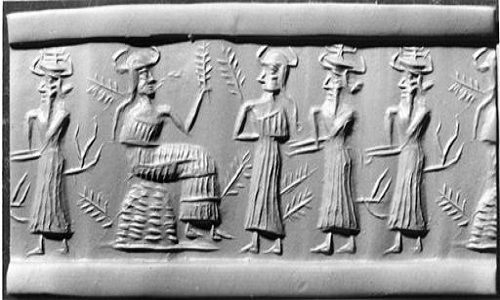Difference Between Mesopotamian And Egyptian Religion
Introductory History
Mesopotamia: The term Mesopotamia basically refers to the Tigris-Euphrates river system. As a nation Mesopotamia corresponds to modern day Iraq, Kuwait, northeastern part of Syria, part of southeastern turkey, and some parts of southeastern Iran. Mesopotamia’s historical existence corresponds to the Bronze Age i. e. roughly between 3rd millennium till 10th century AD. Ruling empires of Bronze Age Mesopotamia included Sumerian, Akkadian, Babylonian, Assyrian empires. Mesopotamia is widely believed, especially in the western world, as the cradle of civilization. Mesopotamian religion refers to the religious practices of Sumerian, East Semitic Akkadian, Assyrian, Babylonian, and migrant Arameans and Chaldeans. The religion existed for nearly 4200 years from the 4th millennium BCE. For thousands of years, polytheism was the dominant religious ideology. Polytheism existed in the region till the 3rd century CE when monotheist religious beliefs like Syrian Christianity, Judaism, Manichaeism, and Gnosticism emerged. By 4th century CE polytheism almost ended in Mesopotamia barring some Assyrian communities who kept polytheism alive till the end of 10th century CE.
Egypt: Egypt, one of the oldest nation states, is a Mediterranean country in the Nile valley bordering Israel in the northeast, Gulf of Aqaba in east, Red Sea in south and east, Sudan in south, and Libya in the west. History of human settlements in Egypt dates back to 40000 years BC. Rule of Pharaoh Dynasty began around 3150 BC, and continued till 332 BC when Macedonian ruler Alexander the Great conquered Egypt and Hellenistic Ptolemaic Kingdom was established. Around 30 BC Rome conquered Egypt, and Roman rule continued till 641 CE. During this period Islamic invaders conquered Egypt, and the nation got appropriated by successive Islamic Caliphates and rulers. In 1517 AD Ottoman dynasty came into power and ruled till 1867 AD. Then came the British to rule the country till 1953 AD. The modern Egypt as a sovereign state as we see today was born in 1953 AD. Like Mesopotamia, the central religious idea of ancient Egypt was polytheism. Religion was at the core of social life of people, and the beliefs and ritualistic system were very complex. Pharaohs were considered the intermediaries between the Gods and the people.
In both the ancient civilizations of Mesopotamia and Egypt religion was embedded in the social and personal life of the people. Religious laws and customs were central to the day-to-day life of the citizens irrespective of their social position. Both the civilizations were ruled by dynasties and the kings were believed to rule by divine power. In spite of the similarities as regards polytheism and divine power of kings, there existed some differences between the two civilizations as regards position of the kings and religious practices. The major differences are mentioned below.
Gods
Mesopotamia: Gods and goddesses representing nature and natural events were mainly worshipped by the city states of Mesopotamia. The gods and goddesses were viewed as the supreme controllers of law, weather, and fertility. God’s wishes and dictates were interpreted and implemented by the priests and kings. These priests obtained divine power by marrying the priestesses of the gods. The most worshipped gods were Enlil, the god of storm and earth; Anu, the god of Sky; Ea or Enki, the god of water; Utu, the sun god; Nanna, the moon god and Inanna or Ishtar, the goddess of fertility. At one point of time as fear of war superseded that of fertility, the gods were viewed as military leaders and protectors of the people. At later stages gods were again viewed as guardians of the people bestowing love and prosperity to the people.
Egypt:
Like Mesopotamians, Egyptians also worshipped nature in the form of gods and goddesses. Amen or Amon was the king of gods. Ra was the sun god, and Osiris was the god of Nile and the dead. Isis, the moon goddess was the consort of Orisis and also the archetypal mother of creation. Horus, the son of Isis and Orisis was the sky god, and Thoth was the god of knowledge. Pharaoh Akhenaton tried to introduce monotheism during 1570 BC, but his successor Tutankhamen brought back polytheism.
Kings’ divine power
Mesopotamia: In Mesopotamia kings were viewed as interpreters of divine law who ruled on behalf of the state, but were not considered as god.
Egypt: Pharaohs, the rulers of Egypt were themselves viewed as god by the people in their own rights and responsibilities, and enjoyed the status of god throughout Egypt. The Pharaohs were perceived as having power to control fertility of soil and prosperity of the people and the authority to translate divine order and justice into laws.
Afterlife
Mesopotamia: There is no evidence to show that the Mesopotamians believed in afterlife.
Egypt: Belief in afterlife and resurrection of the dead were a chief characteristic of religious views of ancient Egyptians. In the earlier stages only Pharaoh were believed to resurrect after death and as such dead bodies of Pharaohs were preserved in mummy with other things like cloths, gems, and other items of daily use. Later the practice rolled down to the common people as well.
Summary
- The civilizations worshipped different gods and goddesses.
- The Pharaohs of Egypt were considered god, but in Mesopotamia they were considered as intermediaries between god and the people.
- People of Mesopotamia did not believe in afterlife, but afterlife and resurrection of dead were the chief characteristic of Egyptian religious beliefs.
- Differences between Al-Qaeda And ISIS - April 14, 2017
- Difference Between Hindu And Buddhist meditation - September 20, 2015
- Difference Between Upper Middle Class and Lower Middle Class - September 3, 2015
Search DifferenceBetween.net :
Leave a Response
References :
[0]http://people.opposingviews.com/did-mesopotamian-egyptian-religious-systems-differ-5595.html
[1]www.encyclopedia.com › … › January 2007
[2]https://commons.wikimedia.org/wiki/File:Mesopotamian_-_Cylinder_Seal_-_Walters_42564_-_Impression.jpg

